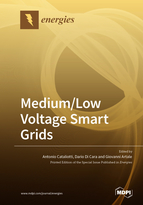Medium/Low Voltage Smart Grids
A special issue of Energies (ISSN 1996-1073). This special issue belongs to the section "A1: Smart Grids and Microgrids".
Deadline for manuscript submissions: closed (30 June 2020) | Viewed by 17260
Special Issue Editors
Interests: distributed measurement and control systems for MV and LV distribution networks; power quality measurements; harmonic source detection; power line communications and smart grids
Interests: MV and LV real-time network management; load flow; power line communications; smart grid solutions; transducer characterization in non-sinusoidal conditions
Special Issues, Collections and Topics in MDPI journals
Interests: power quality measurements; power line communications; intelligent electronic devices; power system measurements; harmonic analysis algorithms; smart grids
Special Issue Information
Dear Colleagues,
In the past decade, medium-voltage (MV) and low-voltage (LV) distribution networks have been experiencing many changes due to the high increase of distributed generation from renewable energy sources, the connection of new electric loads (e.g., electric vehicles), the integration of energy storage systems, the progressive participation of passive users in demand response strategies, the introduction of new players in the energy market (e.g., energy aggregators, virtual power plants (VPPs), etc.), and the development of novel strategies for smart metering and power quality issues. In this panorama, distribution system operators need to revise their network management strategies, performing a constant monitoring of the whole distribution network and interacting with distributed generators, energy storage systems, passive users, and energy aggregators. Toward this aim, innovative solutions are needed for accurate distributed measurement systems; intelligent electronic devices and management strategies for distributed generators and energy storage systems; smart metering; load flow and state estimation algorithms; and communication systems to acquire distributed measurement data, send commands, and receive alarms, energy transactions recording and validation (e.g. using blockchain technologies) and cyber attacks prevention. The introduction of these innovative solutions can pave the way for the effective transformation of MV and LV networks into smart grids.
Within this framework, Guest Editors are inviting experts to contribute to this Special Issue by submitting papers dealing with, but not limited to, the following research areas and their applications in MV and LV smart grids:
- Distribution network monitoring and management;
- Distributed measurement systems and their accuracy requirements;
- Meter placement and load flow algorithms;
- Measurement instruments and transducers;
- Distributed generators and energy storage systems integration;
- Energy aggregators and demand response strategies in the future energy market;
- Micro-grid and VPP development and management;
- Communication systems in MV and LV grids;
- Intelligent Electronic Devices integrating measurement, control, and communication capabilities;
- Power quality analysis;
- Smart metering;
- Cyber-physical security in electrical distribution networks;
- Blockchain technology application to MV and LV grids
Prof. Dr. Antonio Cataliotti
Dr. Dario Di Cara
Dr. Giovanni Artale
Guest Editors
Manuscript Submission Information
Manuscripts should be submitted online at www.mdpi.com by registering and logging in to this website. Once you are registered, click here to go to the submission form. Manuscripts can be submitted until the deadline. All submissions that pass pre-check are peer-reviewed. Accepted papers will be published continuously in the journal (as soon as accepted) and will be listed together on the special issue website. Research articles, review articles as well as short communications are invited. For planned papers, a title and short abstract (about 100 words) can be sent to the Editorial Office for announcement on this website.
Submitted manuscripts should not have been published previously, nor be under consideration for publication elsewhere (except conference proceedings papers). All manuscripts are thoroughly refereed through a single-blind peer-review process. A guide for authors and other relevant information for submission of manuscripts is available on the Instructions for Authors page. Energies is an international peer-reviewed open access semimonthly journal published by MDPI.
Please visit the Instructions for Authors page before submitting a manuscript. The Article Processing Charge (APC) for publication in this open access journal is 2600 CHF (Swiss Francs). Submitted papers should be well formatted and use good English. Authors may use MDPI's English editing service prior to publication or during author revisions.
Keywords
- smart grid
- smart metering
- power quality
- load flow
- distribution measurement systems
- distributed generation
- energy storage systems
- microgrids
- meter placement
- power system communication
- blockchain
- cyber-security







